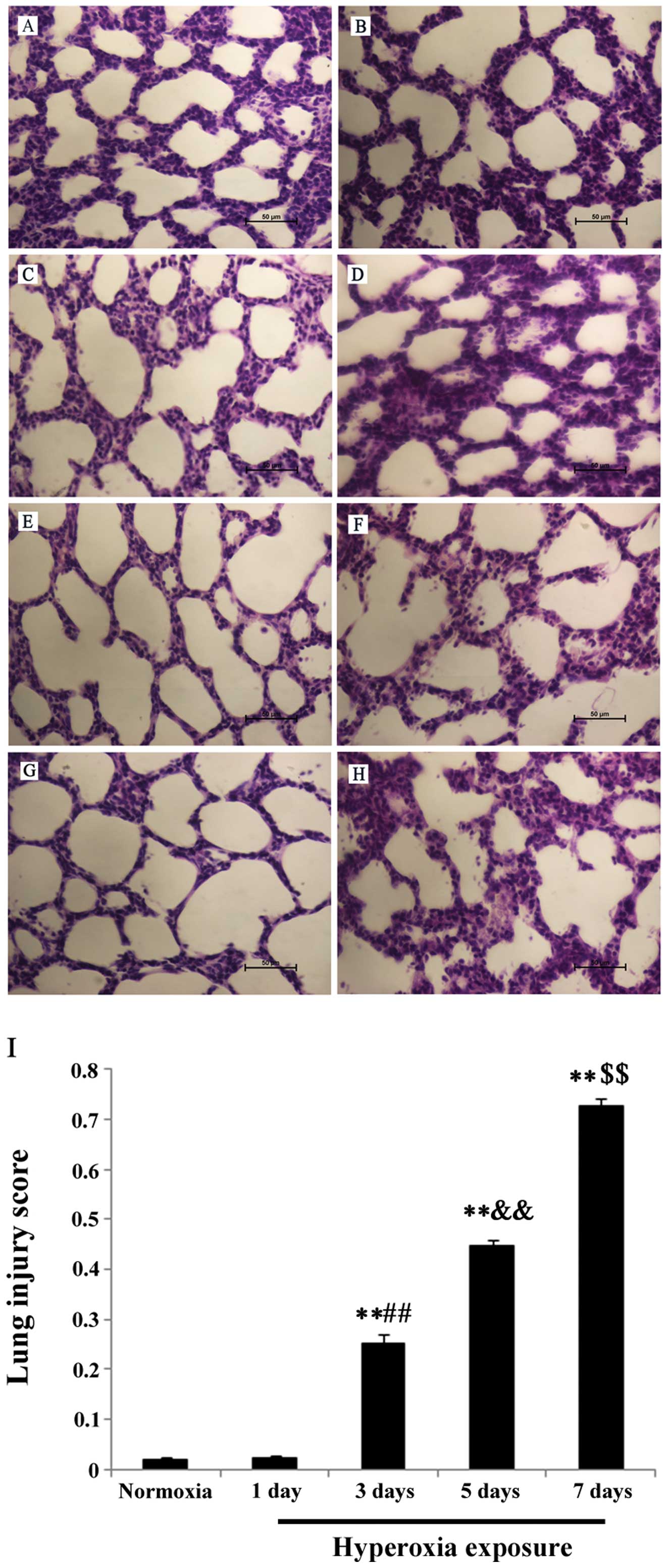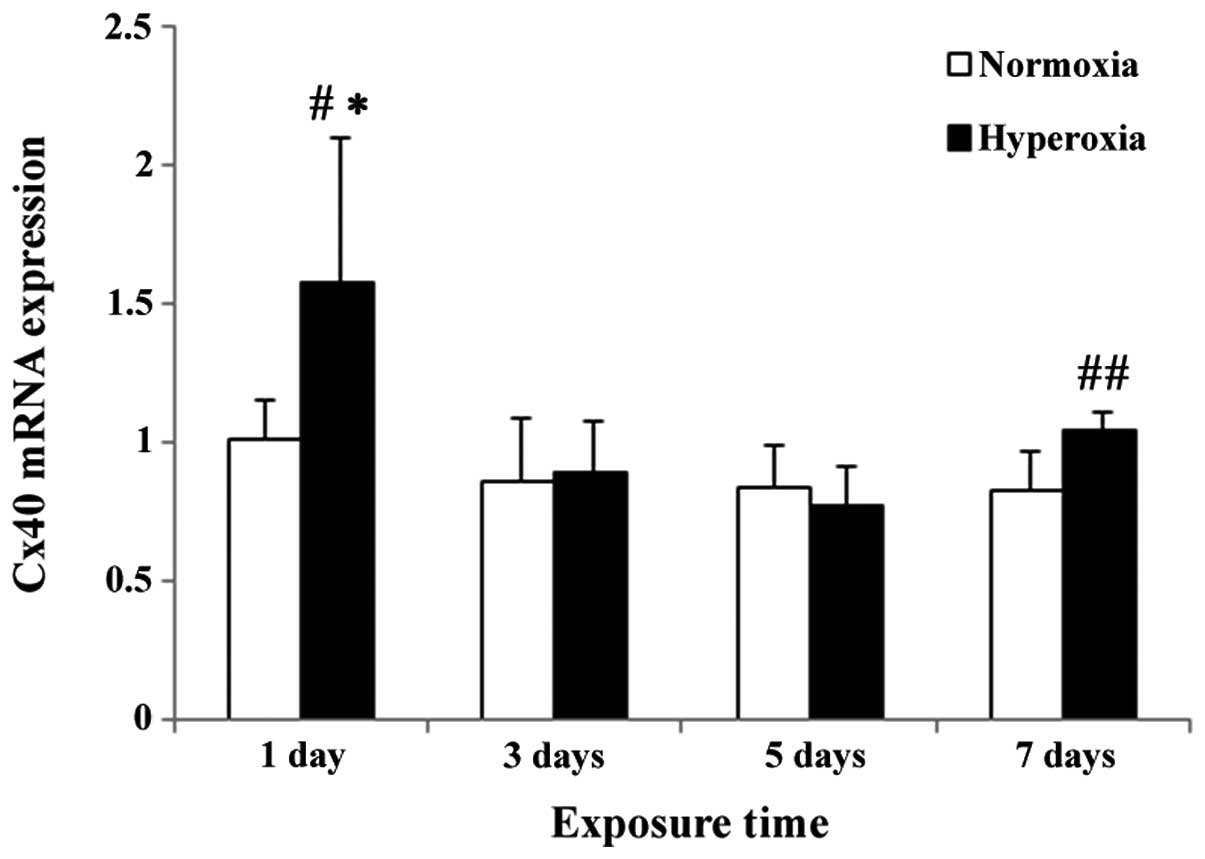|
1
|
Bhandari A and Bhandari V: ‘New’
bronchopulmonary dysplasia: a clinical review. Clin Pulm Med.
18:137–143. 2011.
|
|
2
|
Trembath A and Laughon MM: Predictors of
bronchopulmonary dysplasia. Clin Perinatol. 39:585–601. 2012.
View Article : Google Scholar
|
|
3
|
Coalson JJ: Pathology of bronchopulmonary
dysplasia. Semin Perinatol. 30:179–184. 2006. View Article : Google Scholar : PubMed/NCBI
|
|
4
|
Doyle LW, Faber B, Callanan C, Freezer N,
Ford GW and Davis NM: Bronchopulmonary dysplasia in very low birth
weight subjects and lung function in late adolescence. Pediatrics.
118:108–113. 2006. View Article : Google Scholar : PubMed/NCBI
|
|
5
|
Iles KE, Song W, Miller DW, Dickinson DA
and Matalon S: Reactive species and pulmonary edema. Expert Rev
Respir Med. 3:487–496. 2009. View Article : Google Scholar : PubMed/NCBI
|
|
6
|
Kolliputi N, Shaik RS and Waxman AB: The
inflammasome mediates hyperoxia-induced alveolar cell permeability.
J Immunol. 184:5819–5826. 2010. View Article : Google Scholar : PubMed/NCBI
|
|
7
|
Bhandari V and Elias JA: Cytokines in
tolerance to hyperoxia-induced injury in the developing and adult
lung. Free Radic Biol Med. 41:4–18. 2006. View Article : Google Scholar : PubMed/NCBI
|
|
8
|
You K, Xu X, Fu J, Xu S, Yue X, Yu Z and
Xue X: Hyperoxia disrupts pulmonary epithelial barrier in newborn
rats via the deterioration of occluding and ZO-1. Respir Res.
13:362012. View Article : Google Scholar : PubMed/NCBI
|
|
9
|
Jobe AH and Kallapur SG: Long term
consequences of oxygen therapy in the neonatal period. Semin Fetal
Neonatal Med. 15:230–235. 2010. View Article : Google Scholar : PubMed/NCBI
|
|
10
|
Barazzone C and White CW: Mechanisms of
cell injury and death in hyperoxia: role of cytokines and Bcl-2
family proteins. Am J Respir Cell Mol Biol. 22:517–519. 2000.
View Article : Google Scholar : PubMed/NCBI
|
|
11
|
Crapo JD, Barry BE, Foscue HA and
Shelburne J: Structural and biochemical changes in rat lungs
occurring during exposures to lethal and adaptive doses of oxygen.
Am Rev Respir Dis. 122:123–143. 1980.PubMed/NCBI
|
|
12
|
Perkett EA and Klekamp JG: Vascular
endothelial growth factor expression is decreased in rat lung
following exposure to 24 or 48 hours of hyperoxia: implications for
endothelial cell survival. Chest. 114:52S–53S. 1998. View Article : Google Scholar : PubMed/NCBI
|
|
13
|
Saez JC, Berthoud VM, Branes MC, Martinez
AD and Beyer EC: Plasma membrane channels formed by connexins:
their regulation and functions. Physiol Rev. 83:1359–1400.
2003.PubMed/NCBI
|
|
14
|
Ale-Aqha N, Albrecht C and Klotz LO: Loss
of gap junctional intercellular communication in rat lung
epithelial cells exposed to quartz particles. Biochem Biophys Res
Commun. 390:44–47. 2009. View Article : Google Scholar : PubMed/NCBI
|
|
15
|
Rignault S, Haefliger JA, Waeber B,
Liaudet L and Feihl F: Acute inflammation decrease the expression
of connexin 40 in mouse lung. Shock. 28:78–85. 2007. View Article : Google Scholar : PubMed/NCBI
|
|
16
|
Elzarrad MK, Haroon A, Willecke K,
Dobrowolski R, Gillespie MN and Al-Mehdi AB: Connexin-43
upregulation in micrometastases and tumor vasculature and its role
in tumor cell attachment to pulmonary endothelium. BMC Med.
6:202008. View Article : Google Scholar : PubMed/NCBI
|
|
17
|
Li Q, Zhang J, Wang W, et al: Connexin 40
modulates pulmonary permeability through gap junction channel in
acute lung injury after thoracic gunshot wounds. J Trauma.
68:802–809. 2010. View Article : Google Scholar : PubMed/NCBI
|
|
18
|
Zhang J, Wang W, Sun J, et al: Gap
junction channel modulates pulmonary vscular permeability through
calcium in acute lung injury: an experimental study. Respiration.
80:236–245. 2010. View Article : Google Scholar : PubMed/NCBI
|
|
19
|
Matute-Bello G, Downey G, Moore BB, et al;
Acute Lung Injury in Animals Study Group. An official American
Thoracic Society workshop report: features and measurements of
experimental acute lung injury in animals. Am J Respir Cell Mol
Biol. 44:725–738. 2011. View Article : Google Scholar : PubMed/NCBI
|
|
20
|
Huang X and Zhao YY: Transgenic expression
of FoxM1 promotes endothelial repair following lung injury induced
by polymicrobial sepsis in mice. PLoS One. 7:e500942012. View Article : Google Scholar : PubMed/NCBI
|
|
21
|
Coalson JJ, Winter VT, Siler-Khodr T and
Yoder BA: Neonatal chronic lung disease in extremely immature
baboons. Am J Respir Crit Care Med. 160:1333–1346. 1999. View Article : Google Scholar : PubMed/NCBI
|
|
22
|
Ji W, Fu J, Nie H and Xue X: Expression
and activity of epithelial sodium channel in hyperoxia-induced
bronchopulmonary dysplasia in neonatal rats. Pediatr Int.
54:735–742. 2012. View Article : Google Scholar : PubMed/NCBI
|
|
23
|
Ben-Ari J, Makhoul IR, Dorio RJ, Buckley
S, Warburton D and Walker SM: Cytokine response during hyperoxia:
sequential production of pulmonary tumor necrosis factor and
interleukin-6 in neonatal rats. Isr Med Assoc J. 2:365–369.
2000.PubMed/NCBI
|
|
24
|
Auten RL and Davis JM: Oxygen toxicity and
reactive oxygen species: the devil is in the details. Pediatr Res.
66:121–127. 2009. View Article : Google Scholar : PubMed/NCBI
|
|
25
|
Yucel O, Kunak ZI, Macit E, Gunal A,
Gozubuyuk A, Gul H and Genc O: Protective efficiacy of taurine
against pulmonary edema progression: experimental study. J
Cardiothorac Surg. 3:572008. View Article : Google Scholar : PubMed/NCBI
|
|
26
|
Doyle LW, Ehrenkranz RA and Halliday HL:
Dexamethasone treatment in the first week of life for preventing
bronchopulmonary dysplasia in preterm infants: a systematic review.
Neonatology. 98:217–224. 2010. View Article : Google Scholar : PubMed/NCBI
|
|
27
|
Dani C, Cecchi A and Bertini G: Role of
oxidative stress as physiopathologic factor in the preterm infant.
Minerva Pediatr. 56:381–394. 2004.(in English, Italian).
|
|
28
|
Yin Q, Nan H, Yan L, Huang X, Wang W, Cui
G and Wei J: Alteration of tight junctions in pulmonary
microvascular endothelial cells in bleomycin-treated rats. Exp
Toxicol Pathol. 64:81–91. 2012. View Article : Google Scholar : PubMed/NCBI
|
|
29
|
Trovato-Salinaro A, Trovato-Salinaro A,
Failla M, et al: Altered intercellular communication in lung
fibroblast cultures from patients with idiopathic pulmonary
fibrosis. Respir Res. 7:1222006. View Article : Google Scholar : PubMed/NCBI
|
|
30
|
Simon AM, McWhorter AR, Chen H, Jackson CL
and Ouellette Y: Decreased intercellular communication and connexin
expression in mouse aortic endothelium during
lipopolysaccharide-induced inflammation. J Vasc Res. 41:323–333.
2004. View Article : Google Scholar
|
|
31
|
Wang L, Yin J, Nickles HT, et al: Hypoxic
pulmonary vasoconstriction requires connexin 40-mediated
endothelial signal conduction. J Clin Invest. 122:4218–4230. 2012.
View Article : Google Scholar : PubMed/NCBI
|
|
32
|
Giepmans BN: Gap junctions and
connexin-interacting proteins. Cardiovasc Res. 62:233–245. 2004.
View Article : Google Scholar : PubMed/NCBI
|
|
33
|
Toyofuku T, Yabuki M, Otsu K, Kuzuya T,
Hori M and Tada M: Direct association of the gap junction protein
connexin-43 with ZO-1 in cardiac myocytes. J Biol Chem.
273:12725–12731. 1998. View Article : Google Scholar : PubMed/NCBI
|
|
34
|
Herve JC, Bourmeyster N and Sarrouilhe D:
Diversity in protein-protein interactions of connexins: emerging
roles. Biochim Biophys Acta. 1662:22–41. 2004. View Article : Google Scholar : PubMed/NCBI
|
|
35
|
Valiunas V, Gemel J, Brink PR and Beyer
EC: Gap junction channels formed by coexpressed connexin 40 and
connexin 43. Am J Physiol Heart Circ Physiol. 281:H1675–H1689.
2001.PubMed/NCBI
|
|
36
|
Nagasawa K, Chiba H, Fujita H, Kojima T,
Saito T, Endo T and Sawada N: Possible involvement of gap junctions
in the barrier function of tight junctions of brain and lung
endothelial cells. J Cell Physiol. 208:123–132. 2006. View Article : Google Scholar : PubMed/NCBI
|
|
37
|
Coalson JJ: Pathology of new
bronchopulmonary dysplasia. Semin Neonatol. 8:73–81. 2003.
View Article : Google Scholar
|
|
38
|
Warner BB, Stuart LA, Papes RA and Wispé
JR: Functional and pathological effects of prolonged hyperoxia in
neonatal mice. Am J Physiol. 275:L110–L117. 1998.PubMed/NCBI
|















